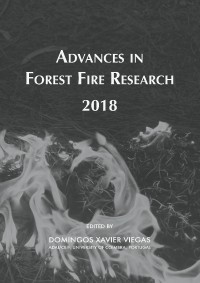Please use this identifier to cite or link to this item:
https://hdl.handle.net/10316.2/44566| DC Field | Value | Language |
|---|---|---|
| dc.contributor.author | Raimundo, António M. | |
| dc.contributor.author | Oliveira, A. Virgílio M. | |
| dc.contributor.author | Quintela, Divo A. | |
| dc.contributor.author | Figueiredo, A. Rui | |
| dc.date.accessioned | 2018-11-09T13:10:42Z | |
| dc.date.accessioned | 2020-09-06T17:31:25Z | - |
| dc.date.available | 2018-11-09T13:10:42Z | |
| dc.date.available | 2020-09-06T17:31:25Z | - |
| dc.date.issued | 2018 | - |
| dc.identifier.isbn | 978-989-26-16-506 (PDF) | |
| dc.identifier.uri | https://hdl.handle.net/10316.2/44566 | - |
| dc.description.abstract | The main objective of this work is to establish useful guide-lines for secure firefighting, namely the evaluation of the influence of fire intensity, personal protective clothing properties and application of body cooling techniques on safety during firefighting operations. The physiological reaction of men exposed to these conditions is obtained by numerical simulation using a software implemented by the authors. The protocol adopted submits the firefighter to four phases: neutral, pre-firefighting, firefighting and recovering. On the fire-fighting phase, the properties of the firefighter protective clothing depend on the test settings (values of intrinsic insulation between 0 and 9 clo were considered). In this phase, the firefighter, doing hard work (M = 3.0 met), is exposed to an impinging radiation in an environment with Tair = Tmr = 50 ºC. Incident radiation fluxes (Irad ) between 0 and 40 kW m-2 were considered. On the recovering period, the firefighter is far from the fire and has a low level of activity (M = 1.2 met). Six alternative body cooling techniques were analyzed, which are applied only during the recovering period: passive cooling; use of an ice jacket; immersion of hands and forearms in water at 20ºC and at 10ºC; use of an ice jacket reinforced by immersion of hands and forearms in water at 10ºC; and all body (except head and neck) immersion in water at 25ºC. From a safety point of view, the most important indicator seems to be the time delay for the onset of heat stroke (fainting). The threshold for introversion is a good indicator to assess the exposure periods that must not be exceeded. As expected, the predicted results indicate that the firefighter thermal stress level depends primarily on the intensity of the incoming radiation, on the time of exposure to it and on the clothing thermal insulation. Time safety intervals decrease with the increase of the impinging thermal radiation and increase with the insulation of the ensemble. However, clothing high thermal insulation can hide dangerous situations. Thus, a convenient control of the duration of firefighting periods it is crucial. For the situation of Irad = 5 kW m-2 and an active fighting period of 20-minutes, the cooling techniques tested can be ordered from the less effective to the highest one as: 6th) passive cooling; 5th) use of an ice jacket; 4rd) immersion of hands and forearms in water at 20ºC; 3rd) the same but with water at 10ºC; 2nd) use of an ice jacket reinforced by immersion of hands and forearms in water at 10ºC; and 1st) all body (except head and neck) immersion in water at 25ºC. Among the tested, the strategy of immersion the entire body in water at 25ºC is undoubtedly substantially much more effective than the others. | eng |
| dc.language.iso | eng | - |
| dc.publisher | Imprensa da Universidade de Coimbra | por |
| dc.relation.ispartof | http://hdl.handle.net/10316.2/44517 | por |
| dc.rights | open access | - |
| dc.subject | Safety firefighting | eng |
| dc.subject | Human thermoregulation modelling | eng |
| dc.subject | Times for the onset of heat-related illness | eng |
| dc.title | Fire intensity, individual protective clothing and firefighting safety | por |
| dc.type | bookPart | por |
| uc.publication.firstPage | 454 | - |
| uc.publication.lastPage | 465 | - |
| uc.publication.location | Coimbra | por |
| dc.identifier.doi | 10.14195/978-989-26-16-506_49 | - |
| uc.publication.section | Chapter 3 - Fire Management | por |
| uc.publication.digCollection | PB | por |
| uc.publication.orderno | 49 | - |
| uc.publication.area | Ciências da Engenharia e Tecnologias | por |
| uc.publication.bookTitle | Advances in forest fire research 2018 | - |
| uc.publication.manifest | https://dl.uc.pt/json/iiif/10316.2/44566/204139/manifest?manifest=/json/iiif/10316.2/44566/204139/manifest | - |
| uc.publication.thumbnail | https://dl.uc.pt/retrieve/11058171 | - |
| uc.publication.parentItemId | 55072 | - |
| uc.itemId | 68829 | - |
| item.grantfulltext | open | - |
| item.fulltext | With Fulltext | - |
| Appears in Collections: | Advances in forest fire research 2018 | |
Files in This Item:
| File | Description | Size | Format | |
|---|---|---|---|---|
| fire_intensity__individual_protective_clothing.pdf | 1.16 MB | Adobe PDF |  |
Items in DSpace are protected by copyright, with all rights reserved, unless otherwise indicated.
